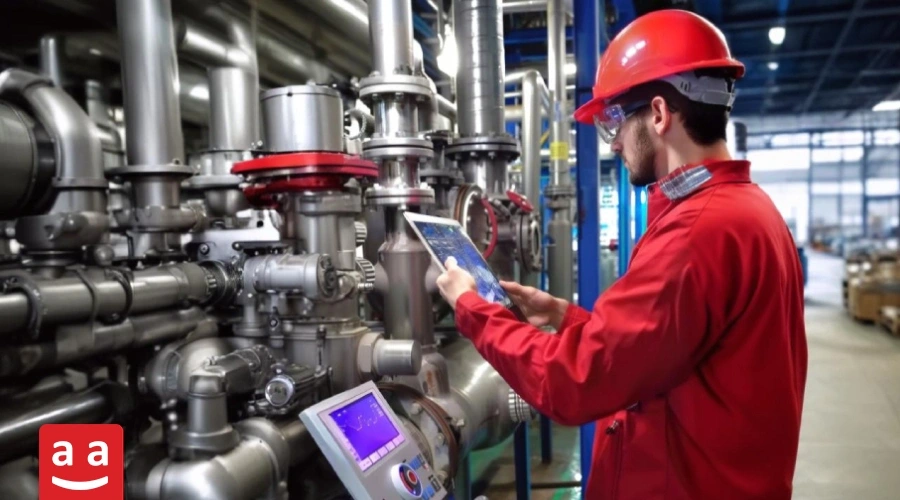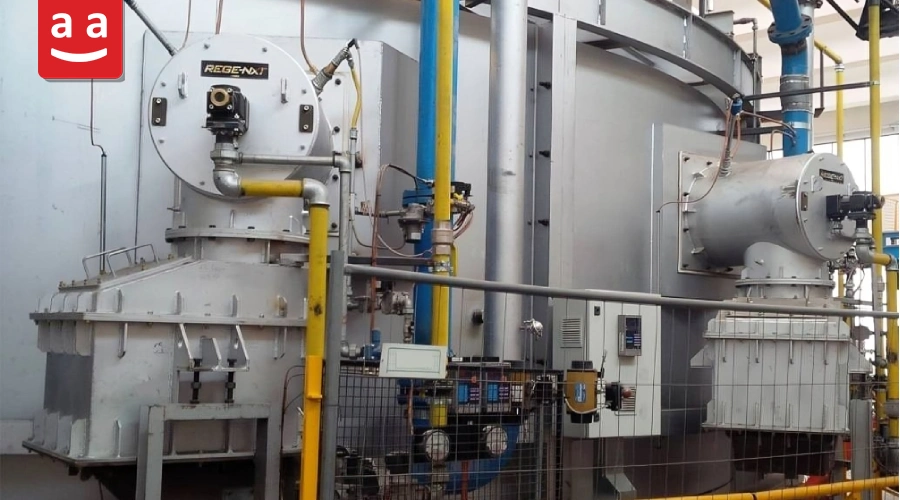Liquefied Petroleum Gas (LPG), as a fossil fuel and its combustion, plays a crucial role in energy production across various industries. LPG, a mixture of propane and butane, is widely used in industrial burners as a primary or alternative fuel due to its ease of portability and storage. The combustion of this fuel, especially under conditions where forced draft air is provided, has highly efficient and generally generates less pollution than liquid fuels.
This article explores the combustion process of liquefied petroleum gas (LPG) in industrial burners using forced draft air, along with the factors affecting its quality and efficiency.
What is liquefied petroleum gas (LPG)?
Liquefied Petroleum Gas (LPG) is a mixture of two hydrocarbon gases, butane and propane, which turns into liquid under pressure. In some cases, small amounts of other gases such as propylene and butylene are also present in this mixture. The ratio of these gases varies with ambient temperature; for instance, in summer, the mixture contains a higher proportion of butane, while in winter, due to propane’s lower boiling and evaporation temperatures, the proportion of propane increases.
LPG is mainly used for heating applications and as a fuel for vehicles. It is also employed in various industries, including the production of aerosols and as a refrigerant gas in refrigerators and freezers.
Physical and Chemical Properties of LPG
LPG is produced as a byproduct of natural gas and crude oil refining. It is a mixture of propane and methane, with a Wobbe Index ranging from 72-87 MJ/m3. This gas has a high calorific value (around 46 MJ/kg), which is higher than gasoline and fuel oil, meaning it produces more energy for the same weight. However, since LPG has a lower density, it produces less energy than gasoline when compared by volume.
At 15°C, one liter of liquefied petroleum gas (LPG) weighs between 500 and 560 grams. The gas is colorless, odorless, and tasteless when produced, but sulfur compounds are added to it to provide an odor for safety reasons. The internal pressure of LPG tanks reaches up to 8 bar when they are full.
Comparison of LPG with other common fuels
The table below compares the characteristics of LPG with gasoline and oil.


The combustion of liquefied petroleum gas (LPG) generates less carbon dioxide compared to liquid and solid fuels but emits more than natural gas. The diagram below illustrates the comparison of CO2 emissions per kilowatt-hour of energy generated from the combustion of different fuels. In general, the CO2 emissions per kilowatt-hour of energy generated from the combustion of liquefied petroleum gas (LPG) are approximately 90% of those produced by oil and 70% of those produced by coal. However, LPG emits more carbon dioxide compared to natural gas.


Guidelines for using liquefied petroleum gas
Using liquefied petroleum gas (LPG) in industrial burners requires special safety and technical precautions due to the unique properties of this fuel. LPG is usually stored and transported in spherical or cylindrical tanks. The reason for using these types of tanks is the high storage pressure of the fuel, which can be dangerous if leakage or lack of control occurs. Liquefied petroleum gas (LPG) is stored in these tanks under high pressure in a liquid form but is used and burned in a gaseous state within burners. The process of evaporating LPG and converting it from liquid to gas requires energy.
The evaporation rate of liquefied petroleum gas (LPG) must correspond to the fuel consumption rate of the burner. In storage tanks, LPG partially evaporates naturally, with the natural evaporation rate influenced by ambient temperature and the tank’s wetted area. For low-capacity systems, natural evaporation is typically adequate. However, in high-capacity industrial systems, natural evaporation alone is insufficient. To ensure a consistent and adequate flow and pressure of LPG, specialized equipment known as evaporators is employed. Additionally, evaporators help prevent problems such as freezing and frost buildup on the equipment.


Vaporizer
In an evaporator, incoming LPG absorbs heat and evaporates, preparing it for use in the burner. Evaporators maintain a steady and continuous gas flow, ensuring that liquefied petroleum gas (LPG) is delivered to the burner in a stable and optimal form, while also preventing equipment from freezing. The use of these devices stabilizes the combustion process and ensures the efficient operation of industrial burners. LPG evaporators are typically divided into three main categories:
Electric vaporizers: In this type of evaporator, an electric current flows through a heating element inside the tank, causing it to heat up. The generated heat then promotes the evaporation of liquefied petroleum gas (LPG).


Direct fired vaporizers: In these evaporators, a small amount of LPG is burned, and the resulting heat is used to evaporate the necessary volume of liquefied petroleum gas (LPG). They are called “direct fired evaporators” because the flame directly heats the LPG, converting it into gas. This type of evaporator is commonly used in LPG combustion systems.


Vaporizers with steam or hot water as the heat source: In this method, a heat exchanger is used to transfer heat from steam or hot water to the liquefied gas. The liquefied gas enters on one side of the exchanger, and steam or hot water flows on the other side. The thermal energy from the steam or hot water vaporizes the liquefied gas.


Each of these three categories has specific applications based on the requirements and consumption capacity of liquefied petroleum gas.
Regulator
To install the LPG storage tank and vaporizers, it is necessary to use two regulators. For more information about gas train regulators, you can read the article Gas Regulators; An Overview of 11 Different Types and the best Brands.
Primary regulator: This regulator, also known as the high-pressure regulator, is responsible for reducing the gas pressure from the tank pressure (8 bar) to 1 bar. It should be installed after the vaporizer and close to it to ensure the gas pressure is reduced to the appropriate level after vaporization.
Secondary regulator: This regulator, known as the low-pressure regulator, reduces the gas pressure from 1 bar to the operating pressure of the burner. It must be installed near the burner so that the gas is delivered to the burner at the proper pressure.
LPG Pump
If the distance between the tank and the vaporizer is considerable, the use of a spark-proof electric pump is essential. This pump is installed to overcome pressure drop and ensure a continuous gas flow to the burner. The installation and setup of the tank, vaporizer, and other components of the LPG system are conducted in compliance with National Standard 841, which guarantees the safety and efficiency of liquefied petroleum gas systems.
Figure 6 shows the schematic of the piping between the vaporizer and the storage tank, which must be carefully designed and implemented to prevent leaks and excessive pressure drop, while effectively managing the gas flow.


Emission Standards for Liquid Fuel Combustion
The combustion of liquid fuels, particularly in industries and power plants, can produce various pollutants that negatively affect human health and the environment. To address this, emission standards have been developed to control and reduce these pollutants. The key national standard for LPG-fueled burners is National Standard 7595, titled “Gas-Fired Forced-Air Burners: Characteristics and Test Methods.” This standard defines the design specifications, testing protocols, and emission limits for industrial burners operating with gaseous fuels such as natural gas and liquefied petroleum gas.
For further familiarity with national and international standards related to burners, you can read the article “National and International Standards for Industrial Burners”.
Nitrogen Oxide (NOx) Emissions
The adiabatic flame temperature of methane with 20% excess air is roughly 1800°C, while the adiabatic flame temperature of LPG under the same conditions is approximately 1850°C. Due to the higher flame temperature, liquefied petroleum gas (LPG) generates more nitrogen oxides (NOx) than natural gas. This pollutant can lead to air pollution, acid rain, and respiratory problems. According to National Standard 7595 and European Standard EN-676, LPG-fired burners are categorized based on their NOx emission levels as shown in the table below.


Carbon Monoxide Emissions
As per National Standard 7595 and EN-676, the CO emission level must not exceed 100 milligrams per kilowatt-hour.
Challenges and solutions in the combustion of LPG
LPG combustion in industrial burners with forced draft is a critical process for energy production and heating. LPG, a blend of propane and butane, has a high calorific value and generates fewer pollutants compared to liquid fuels like oil and heavy fuel oil.
Optimizing combustion conditions and utilizing equipment like evaporators are crucial for ensuring the safe and efficient operation of LPG-powered systems. Furthermore, compliance with standards such as National Standard 7595 and European Standard EN-676 plays a key role in controlling harmful pollutant emissions and safeguarding public health.


Raadman Group offers a range of LPG burners (propane and butane) in various capacities, available in NOx classes 2 and 3, for customers. Additionally, Packman Company produces LPG-fueled condensing boilers with capacities of up to 10 million kilocalories per hour, which are also available for purchase.
Recent Advances in LPG Combustion Technology for Industrial Burners
In recent years, LPG combustion technology in industrial burners has undergone significant changes. These advancements aim to improve energy efficiency, reduce emissions, and enhance the safety of combustion systems. The following section explores some of the most important recent developments in this field.
Minimizing Hazardous Pollutant Emissions
A key recent trend is the development of burners designed to significantly reduce the emission of NOx and CO pollutants. Moreover, the precise regulation of the air-to-fuel ratio, along with automated combustion process control, has enabled the optimization of burner performance.
Enhancing Thermal Efficiency through Smart Combustion Control Systems
Recent advancements in Smart Combustion Control systems have enabled real-time monitoring of combustion conditions. By employing sophisticated sensors to measure oxygen levels, temperature, and pressure within the burner, these systems can automatically adjust combustion parameters based on the data collected. This dynamic approach enhances efficiency, reduces fuel consumption, and optimizes the overall performance of the equipment.
Optimization of Evaporator Systems
One of the main challenges in using LPG is the need to vaporize it before combustion. The latest evaporators utilize low-energy electric systems and optimized heat exchangers, which help reduce energy loss and increase the speed of gas preparation for combustion.
Utilizing Digital Technologies for Monitoring and Maintenance
Today, many industrial burner manufacturers use smart control systems to optimize the performance of combustion systems. These technologies enable remote monitoring and the prediction of potential failures, resulting in reduced repair costs and extended equipment lifespan.
New Safety and Environmental Standards
With stricter environmental regulations, industrial burner manufacturers must continuously upgrade the technologies used in their products to meet the safety and environmental requirements defined in the relevant standards.
Liquefied petroleum gas: an efficient fuel for the industry
LPG is one of the best options for use in industrial burners due to its characteristics such as high calorific value, lower pollution, and ease of storage and transportation. This fuel not only generates significant energy but also causes less environmental harm compared to liquid fuels such as oil and heavy fuel oil. To use LPG optimally and safely in industrial burners, it is crucial to follow safety standards, use the right equipment such as vaporizers and regulators, and design the related systems carefully. These steps enhance performance, minimize risks, and control pollutant emissions.
Raadman Group provides suitable solutions for utilizing LPG through the production of advanced burners that comply with international standards. These products not only have high efficiency but also contribute to reducing air pollution and preserving the environment. Using LPG as a clean and effective fuel is a smart choice for industries aiming to improve productivity and sustainability.





